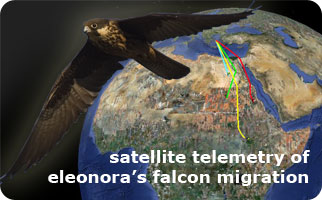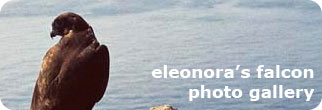 The Aegean bird fauna is characterized by a remarkable diversity of bird species. This diversity is related to the diversity of dwellings but also of landscapes that occur here, and that are related to recent geological phenomena that have contributed to the Aegean's present shape, with its thousands of islands and islets. The geographical position of Greece additionally plays an important role in the high biodiversity of the bird fauna, since by being located at the crossroads of three continents it constitutes the spreading border of many species that do not occur in the rest of Europe (Handrinos and Akriotis 1997).
The Aegean bird fauna is characterized by a remarkable diversity of bird species. This diversity is related to the diversity of dwellings but also of landscapes that occur here, and that are related to recent geological phenomena that have contributed to the Aegean's present shape, with its thousands of islands and islets. The geographical position of Greece additionally plays an important role in the high biodiversity of the bird fauna, since by being located at the crossroads of three continents it constitutes the spreading border of many species that do not occur in the rest of Europe (Handrinos and Akriotis 1997).
The Eleonora's falcon, representing one of the most important species of the Aegean bird fauna, exploits this important diversity of dwellings, creating colonies on rocky island coasts, but also on rocks located in the interior as well as on small uninhabited islets of the Aegean Sea.
More specifically, the rocky coasts of the large islands of the Aegean Sea are crucial ecosystems that offer valuable breeding, feeding and nesting grounds to many bird species, including the Eleonora's falcon, which needs isolation and the feeling of security to nest and breed successfully. The difficult access to the remote slopes minimizes the human presence in these areas, thus permitting the Eleonora's falcons nesting here to find the necessary safety and isolation. The natural cavities and crevices of the rocks and cliffs offer support for the nests and protection from hunters, while the height of the precipices is used during the first flights of the young individuals.
Additionally, the rocky coasts constitute important stations during the migration period for various small-sized birds, especially in areas where there is no other safe shelter, such as on small islets. This fact is exploited by the Eleonora's falcon, to which an inexhaustible source of food is granted during the autumn migration period.
Other, but less important breeding habitats for the Eleonora's falcon are also the rocky formations of the islands, including the rocky surfaces of the ravines and the vertical slopes. These formations, being far removed from the waterfront, constitute impressive elements of the island's landscape, contributing to its uniqueness and distinctiveness. What grants these interior rocks, however, particular value is the isolation they offer, which is necessary to certain bird fauna species that live and breed there, and at the same time also find ideal food-hunting grounds (e.g. in the neighbouring cultivated areas that in turn contribute to the increase of the area's heterogeneity through the creation of new habitats).
 The plethora of uninhabited islets is considered to constitute the most significant contribution to the support of the colonies of the Eleonora's falcon in the Aegean. The absence of human beings as well as terrestrial hunters on these islets is considered especially important for the Eleonora's falcon, since the fact that it can nest even on the ground implies that its nests are exposed to terrestrial hunters. Hence, the islets constitute important breeding shelters for species such as the Eleonora's falcon.
The plethora of uninhabited islets is considered to constitute the most significant contribution to the support of the colonies of the Eleonora's falcon in the Aegean. The absence of human beings as well as terrestrial hunters on these islets is considered especially important for the Eleonora's falcon, since the fact that it can nest even on the ground implies that its nests are exposed to terrestrial hunters. Hence, the islets constitute important breeding shelters for species such as the Eleonora's falcon.
Indeed, while at first sight the rocky coasts of the large and inhabited islands resemble those of the uninhabited islets, in reality they differ significantly from them. The islets are small pieces of land, separated from the larger islands and the mainland villages for many years. The particular conditions that existed on each separate island have led to the creation of unique ecosystems that differ even between neighbouring islets.
The islets' geomorphology, in combination with data of their biogeography, determines which species and habitats occur there. Their location in relation to the larger islands or the mainland as well as the ease of access for boats and disembarkation of humans determine the degree of their isolation. Thus, the most isolated and inaccessible islets have experienced less influence by human activities. For this reason, they function as shelters for rare species of flora and fauna (e.g. the Falco eleonorae) and as vital sites of rest and feeding, particularly for migratory small-sized birds and waders.
Other important species of bird fauna in the breeding habitats of the Eleonora's falcon
Many of the Aegean islets are designated as 'Special Protection Areas' (SPAs), as determined by the European Union Birds Directive 79/409. Under this directive, these islets constitute in other words Important Bird Areas of Greece, since besides the plethora of migratory species that feed and rest on the islets during their migration, they also constitute breeding sites for marine birds and birds of prey that are protected by the Greek and Community legislation, such as the Calonectris diomedea, the Puffinus yelkouan, the Hydrobates pelagicus, the Phalacrocorax aristotelis desmarestii, the Larus audouinii, the Hieraaetus fasciatus, the Buteo rufinus and the Falco peregrinus. Additionally, a significant number of birds are observed on the islets looking for food while nesting on large islands close by and the mainland.










